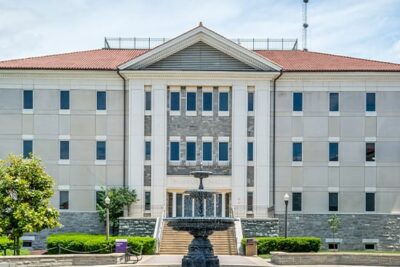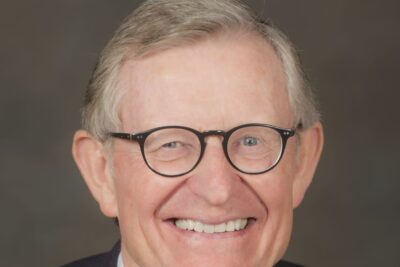
This story is adapted from a Leadership Voices podcast interview with President Ann McElaney-Johnson of Mount Saint Mary’s University.
I’ve heard many fellow presidents say that 2020 has left us in an unending crisis mode. That feeling is familiar to me, because just last October, the Getty Fire came right up to our campus in the Santa Monica mountains, Mount Saint Mary’s University, in Los Angeles.
In the early morning on October 28th, we had to evacuate approximately 1,400 students from one of our two campuses. The wildfire necessitated a complete change to our semester plans overnight, which in many ways informed our response to COVID-19. Below are four of the lessons that we took away from our experience.
1. How to transition to remote and alternative education overnight

Following the evacuation, we decided to move all of our classes to our downtown campus. To accommodate 1,400 students on a campus with limited capacity, we had to create new spaces. We made outdoor art studios and turned meeting rooms into laboratories. We did everything we could do to make sure that every one of our students would finish the semester successfully.
Because space was so limited, some of our faculty members chose to create hybrid courses or convert classes to entirely remote, which served as a dress rehearsal for what we faced during the spring semester.
As a result, when COVID-19 hit, we were already prepared to continue academic programs and related support services without pause. We had learned that with remote classes, it’s necessary to keep in contact with students in a variety of ways, whether by phone or email or text. Most importantly, we learned to keep students engaged so that they succeed in crossing the finish line.
2. What student needs look like in a time of crisis
When our full focus became supporting students, we let go of many of the things that we previously thought to be essential and critical. Asking yourself how to meet the most immediate, basic needs of students opens a whole new imaginative way of thinking.
We had to accommodate 1,400 students on a campus that was not their own and that did not have the space to allow them to live in the way they normally would. We needed to ensure that students felt supported, comforted, and prepared to continue through the semester.
Listen to the full interview
Hear President McElaney-Johnson’s full interview on the Office Hours with EAB podcast.
hear her storyOur students had to leave behind necessities ranging from toiletries to coats when we evacuated campus. We immediately distributed gift cards to students so that they could purchase necessary personal items, and also provided them with gift bags of toiletries. When basic needs were met, we moved on to assisting our students with academic needs, such as replacing their books that were left on our other campus.
We have a high proportion of first-generation, lower-income students at our university so there was significant financial need. We prioritized addressing those concerns and providing resources immediately, and we are doing the same thing now during the pandemic. In a situation where you must think about student needs in this way, you learn what is truly essential to the education experience.
3. How to fulfill our mission and legacy
Our ethos has always been rooted in providing a transformative education in the spirit of our university’s founders, the Sisters of St. Joseph, This congregation of women religious traces its origins to 1650 in France, at the end of a hundred years of war and plague. These women were entrepreneurs right from the start and created new, and at that time, radical ways for women to serve the community. Rather than separating themselves from the community and living in a cloistered setting as was required for women religious of the day, these visionary women rejected tradition and established a residence in the midst of the community they sought to serve.
The Sisters of St. Joseph taught skills to single women who had been exploited into prostitution so that they could earn a living and create life of dignity and security. The Sisters’ mission was to empower women through education and to address the needs of society. We follow that same mission today at Mount Saint Mary’s.
Our legacy calls us to respond to the needs of the time, whatever those needs are. Our experience with the wildfire taught us how to care for our students who were stressed, anxious, and dealing with a traumatic situation. It is essential to think about all the dimensions and complexities of the situation at hand, particularly those that affect our students.
“With crises like wildfires and COVID-19, there is no absolute knowledge of what will happen tomorrow. To lead in a time of uncertainty, it’s critical to be entirely honest.”
– Dr. McElaney-Johnson, president of Mount Saint Mary’s University
4. How to lead and inspire in a time of crisis
With crises like wildfires and COVID-19, there is no absolute knowledge of what will happen tomorrow. To lead in a time of uncertainty, it’s critical to be entirely honest. We are honest with all our constituents that we are facing unknowns—but also that we are scenario planning and have a response for each of the many different ways the fall semester might look.
“There is a certain moment when you must realize that you are no longer in a crisis, but that you are in a new way of living.”
– Dr. McElaney-Johnson
When we were faced with the crisis of the wildfire, our leadership team talked about how to respond to the next crisis. We certainly did not expect that next one to happen the following semester, but we learned a lot together when working through crisis mode.
There is a certain moment when you must realize that you are no longer in a crisis, but that you are in a new way of living. You have to help your team and yourself move away from responding in a tactical manner so that you can use time and talent in other ways. You have to adapt so that you can be responsive in a visionary way and act as the leader that your institution needs.
Dr. Ann McElaney-Johnson is the 12th president of Mount Saint Mary’s University, the only women’s university in Los Angeles. She is Chair of the Board of Directors of the Women’s College Coalition, among other leadership roles. She is recognized as a thought leader for gender equity issues and a champion for innovative teaching and learning.
Leadership Voices is a series spotlighting vision and courage through crisis. Nominate college presidents who have acted with extraordinary leadership at [email protected]
How college presidents lead through crisis
How a public health expert responded to COVID-19 on campus
"Our people are afraid, whether it's our board members, faculty, staff, students, or members of our community. But I am hopeful and confident that information can help us overcome fear," says Dr. Melinda Treadwell, president of Keene State College.
How one university overcame two natural disasters
In times of uncertainty, you need to lead with your heart as well as your head, says Dr. David Hall, the president of the University of the Virgin Islands.


